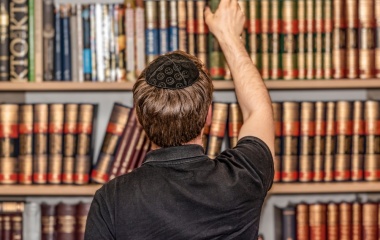
“The appointed one [assistant kohen gadol] said to them [the priests in the Temple]: ‘Recite a single blessing.’ They recited a blessing, and read the aseret hadibrot, Shema, veHaya im Shamoa and vaYomer, blessed the people with three blessings; emet veyatziv, avodah and birchat kohanim, and on Shabbat, they would add a blessing for the outgoing mishmar, priestly watch” (Brachot 11b).
The Rambam explains that the daily recital of the aseret hadibrot is “because they are the most important part of our religion, and its basis”. Rav Saadya Gaon goes so far as to claim that contained within the aseret hadibrot are allusions to each of the 613 mitzvot.
With the aseret hadibrot the primary text of the Torah, there was little reason to confine its daily recital to the Temple. “Rav Yehuda said in the name of Shmuel: They requested to do so outside the Temple, but they had already abolished it because of taromet haminim, the arguments of the heretics” (Brachot 12a). Apparently, the aseret hadibrot were originally part and parcel of the daily ritual of the Jew. But at some point, likely corresponding to the advent of Christianity, the practice was abolished due to the arguments of the heretics.
While the Bavli does not explain what these heretical claims were, the Talmud Yerushalmi explains that the daily recital of the aseret hadibrot was abolished, “lest they say that these alone were given at Sinai”. There was a fear that by emphasizing the importance of the aseret hadibrot, a most worthwhile goal, the rest of the Torah would be viewed as significantly less important—a side effect much too dangerous. Leading the people to believe that much of Torah is man-made is too great a risk to take, even if such meant the diminished perception of importance regarding the aseret hadibrot[1].
By the time of Shmuel, living not much later in Bavel, there was a desire to re-institute the saying of the aseret hadibrot. Yet Shmuel would not allow such. However, the desire to recite the aseret hadibrot was a strong one, and attempts were made to bring its recitation back. Rabba bar bar Chana tried to establish the practice in Sura, but was prevented from doing so by Rav Chisda. A couple generations later, Ameimar sought to establish the practice in Neharda, but he was stopped by Rav Ashi.
If we were to assume that these minim were the early Christians—who still davened in shuls—then the desire to reinstitute the aseret hadibrot in Bavel makes perfect sense. There were few, if any, Christians living there and no one, as Rashi notes, to “tell the ignorant that that the rest of the Torah was not true”—and hence, no reason not to reinstitute its recital. Rabba bar bar Chana, Ameimar and others wanted to restore the old tradition but were prevented from doing so, as the custom of not saying it had already taken hold and was not to be changed[2][3].
While the aseret hadibrot themselves could no longer be said, they were recited in an indirect manner. The Talmud Yerushalmi (Brachot 1:5) wonders why we specifically recite these three paragraphs of the shema. “Rav Levi said, because the aseret hadibrot are included therein”. In other words, we say the shema not so much for its own sake, but because it is an alternate way of saying the aseret hadibrot[4]. One could even argue that the practice to recite the three paragraphs of the shema arose only after the Sages abolished the recital of the aseret hadibrot and was meant as its substitute.
This may seem to be a strange claim, one that flies in the face of the Biblical obligation to recite the shema twice a day. However, it might very well be that the obligation to recite the shema is “only” rabbinic in nature. The source of the obligation of shema—“and you shall recite them…when you lie down and when you wake up” (Devarim 6:7)—may very well be an asmachta, a biblical peg on which to place a rabbinic law. As Abaye argues (Brachot 21a), the simple reading of this verse—which begins, “and you shall teach them to your children”—refers to words of Torah.
However, even if one asserts, as is the generally accepted view, that there is a Biblical mitzvah to recite the shema, that does not necessarily mean all three paragraphs need be said. One may be able to fulfil this mitzvah saying no more than the first sentence. “’Hear O Israel, the Lord our G-d, the Lord is One’—this is the kriat shema of Rabbi Yehuda Hanassi“ (Brachot 13b).
The aseret hadibrot and kriat shema are the twin pillars of Jewish faith. The former are the means by which G-d revealed himself to the people of Israel, giving us our most treasured gift, that of Torah. The latter demonstrate the Jewish people’s acceptance of the Kingdom of G-d and our willingness to perform His mitzvot. We look forward to the day when we will no longer have to worry about the minim and we can once again recite the aseret hadibrot each and every day.
[1] It is for a similar reason that the Rambam—the same Rambam who said that the aseret hadibrot are the most important part of our religion—argues that one should not specifically stand for the aseret hadibrot when they are read in shul. The aseret hadibrot are more important. However, standing for them runs the risk of making the rest of the Torah seem much less important in the eyes of many, and that is a risk the Rambam suggested we ought not take.
[2] The Ben Ish Chai understands the claims of the minim in a much different vein. “They would say, ‘Every day you say the aseret hadibrot, and make a blessing on them; and [yet] you do not observe that which is written in them.’ These are things they trample with their feet: violating the commands of saying G-d’s name in vain, and not to steal, not to be jealous and so, too, honour your father and mother.” It is hard to know (actually, it’s not that hard) which is worse: not believing G-d gave the entire Torah, or believing G-d gave the Torah but not observing it.
[3] I thank Rabbi Wayne Allen for this insight.
[4] The Yerushalmi spells out the parallels as follows: 1. Anochi Hashem = Shema Yisrael ; 2. Lo Yeheyeh = Hashem Echad; 3. Lo Tisa = Veahavta; 4. Zachor et yom Hashabbat = lema’an tizkeeru; 5. Kaved et aveecha = lema’an yirbu yemeichem; 6. Lo tirzach= veavdetem mehera; 7. Lo tinaf = v’lo taturu achrei levavchem; 8. Lo tignov = veasfat degnecha (your grain); 9. Lo taaneh breacha = Ani Hashem Elokeichem; 10. Lo tachmod = uketavtam al mezuzot beitecha.



